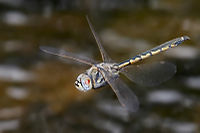
Photo from wikipedia
Reducing weight and increasing lift have been an important goal of using flapping wing micro air vehicles (FWMAVs). However, FWMAVs with mechanisms to limit the angle of attack (α) artificially… Click to show full abstract
Reducing weight and increasing lift have been an important goal of using flapping wing micro air vehicles (FWMAVs). However, FWMAVs with mechanisms to limit the angle of attack (α) artificially by active force cannot meet specific requirements. This study applies a bioinspired model that passively imitates insects' pitching wings to resolve this problem. In this bionic passive pitching model, the wing root is equivalent to a torsional spring. α obtained by solving the coupled dynamic equation is similar to that of insects and exhibits a unique characteristic with two oscillated peaks during the middle of the upstroke/downstroke under the interaction of aerodynamic, torsional, and inertial moments. Excess rigidity or flexibility deteriorates the aerodynamic force and efficiency of the passive pitching wing. With appropriate torsional stiffness, passive pitching can maintain a high efficiency while enhancing the average lift by 10% than active pitching. This observation corresponds to a clear enhancement in instantaneous force and a more concentrated leading edge vortex. This phenomenon can be attributed to a vorticity moment whose component in the lift direction grows at a rapid speed. A novel bionic control strategy of this model is also proposed. Similar to the rest angle in insects, the rest angle of the model is adjusted to generate a yaw moment around the wing root without losing lift, which can assist to change the attitude and trajectory of a FWMAV during flight. These findings may guide us to deal with various conditions and requirements of FWMAV designs and applications.
Journal Title: Applied Bionics and Biomechanics
Year Published: 2019
Link to full text (if available)
Share on Social Media: Sign Up to like & get
recommendations!